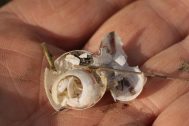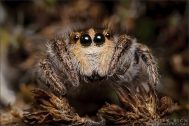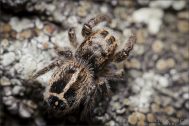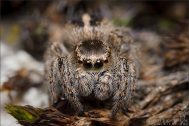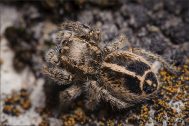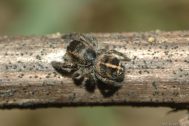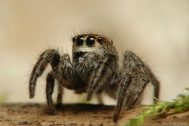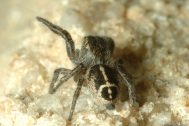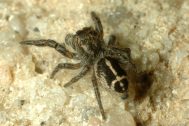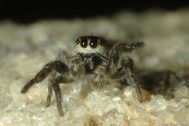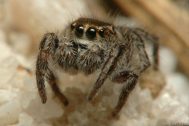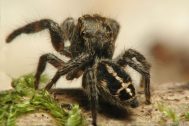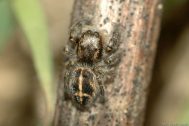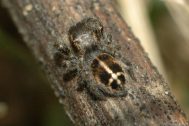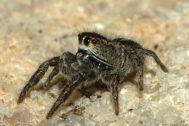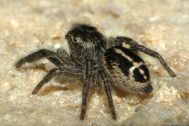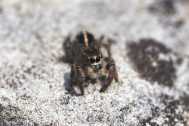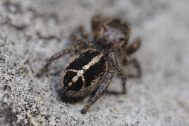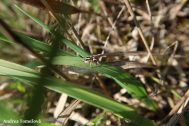| Nálezy podle období | |||||
|---|---|---|---|---|---|
| Salticidae | 0-1900 | 1901-1950 | 1951-2000 | 2001+ | ∑ |
| Pellenes tripunctatus (Walckenaer, 1802) Téměř ohrožený | 6× | 10× | 85× | 68× | 169× |
Pellenes tripunctatus (Walckenaer, 1802)
| České jméno | skákavka křížová |
|---|---|
| Stupeň ohrožení | Téměř ohrožený |
| Nálezy | 169 nálezů, 48 kvadrátů |
| První nález |
1859, F. Prach, Prach 1866 |
| Poslední nález | 2023 |
| Areál rozšíření | Palaearctic - E-T |
| Fytogeografická oblast |
|
| Původnost stanovišť |
|
| Vlhkost stanovišť |
|
| Stratum |
|
| Osvětlení stanovišť |
|
| Hojnost výskytu |
|
| Nadm. výška | 200-750 |
Literatura
Microhabitat selection for overwintering: Overwintering conditions of three jumping spiders (Pellenes tripunctatus, P. nigrociliatus, and Attulus penicillatus) living in terrestrial shells in the Czech Republic.
Taking the regular overwintering of spider species in land snail shells as a model, we studied environmental conditions affecting the choice of overwintering sites in three jumping spider species: Pellenes tripunctatus, Pellenes nigrociliatus, and Attulus penicillatus. The research was conducted at 11 steppe localities on calcareous bedrock with abundant empty shells (mainly Caucasotachea vindobonensis and Xerolenta obvia). We documented 889 shells and collected 186 of them, of which 113 were inhabited by 146 spider individuals (13 species). Our three focal species made up 81.5% of these. We found different environmental preferences between the sexes in Pellenes tripunctatus and Pellenes nigrociliatus. These females preferred shells with more vegetation nearby. In the case of Pellenes tripunctatus, these were shells with a higher proportion of herbs, whereas Pellenes nigrociliatus selected for a higher proportion of moss. In the immediate vicinity of the shells, environmental conditions did not differ significantly. We found insufficient Attulus penicillatus to determine any preferences. We also recorded six overwintering Pellenes tripunctatus individuals in a single shell (in environmental conditions preferred by females), consisting of five females and one male, which indicated an unusual social behavior for these spider species.
Overwintering of spiders in terrestrial molluscs shells in the wider area of Vranov nad Topľou (Slovakia).
Overwintering of spiders in empty snail shells is a little studied topic and in Slovakia similar research has not been carried out yet. Collecting shells was carried out in the eastern part of Slovakia, in winter at the turn of 2012/2013 and 2013/2014. The study was conducted both at the steppe like and post-industrial habitats. A total of 1085 shells were collected with a spider occupation rate 10.69 %. All acquired 116 spiders were classified in ten families. The most abundant spider family was the Salticidae, with a dominant species Pellenes tripunctatus (Walckenaer, 1802). Significant records include Cheiracanthium montanum (L. Koch, 1877) which is considered as vulnerable and Sitticus penicillatus (Simon, 1875) with a lower risk threat according to Red List of Slovakian spiders.
Pavouk 34 (7/2013)
Méně známé druhy pavouků – Hahnia picta; Pár poznámek k druhu Phlegra cinereofasciata; Aj šťúriky dokážu tkať hodváb; Pellenes tripunctatus v ulitách suchomilky obecné na Lichnici v Železných horách; Zoologické dny 2013; 111. seminář České arachnologické společnosti; Česká bibliografie 2013; Britská bibliografie – The Newsletter 125 a 126; Inventarizační zprávy členů ČAS za roky 2005–2008Fotografie
Statistiky
Dle měsíce v roce
Dle nadmořské výšky
Dle metody sběru (169 použitých nálezů)
| Pellenes tripunctatus (Walckenaer, 1802) LC | Samci | Samice | Mláďata | Nálezy |
|---|---|---|---|---|
| Fotografie | 0 | 0 | 0 | 1 |
| Zemní past | 85 | 24 | 11 | 64 |
| Individuální sběr | 9 | 12 | 6 | 28 |
| Neurčeno | 11 | 16 | 3 | 53 |
| Žlutá miska | 10 | 3 | 0 | 12 |
| Smyk | 2 | 7 | 9 | 8 |
| Prosev | 0 | 1 | 0 | 3 |
| Samci | Samice | Mláďata | Nálezy |
Dle biotopu (168 použitých nálezů)
| Pellenes tripunctatus (Walckenaer, 1802) LC | Samci | Samice | Mláďata | Nálezy |
|---|---|---|---|---|
| Kamenolomy | 6 | 7 | 0 | 7 |
| Neurčeno | 75 | 24 | 7 | 96 |
| Xerotermní travinobylinná společenstva | 3 | 5 | 9 | 10 |
| Vřesoviště nižších poloh | 0 | 1 | 0 | 1 |
| Skalní a suťové biotopy | 1 | 1 | 0 | 1 |
| Travnaté stepi | 0 | 1 | 0 | 1 |
| Skalní stepi na jiných horninách | 0 | 0 | 1 | 1 |
| Suché křoviny | 1 | 0 | 0 | 1 |
| Skalní stepi na vápenci | 16 | 7 | 4 | 20 |
| Suché louky | 5 | 12 | 5 | 15 |
| Stinné skály nižších poloh | 1 | 0 | 0 | 1 |
| Porosty borůvek | 3 | 2 | 0 | 5 |
| Pastviny | 0 | 0 | 1 | 1 |
| Ostatní pole | 1 | 0 | 0 | 1 |
| Úhory | 2 | 0 | 0 | 2 |
| Suché doubravy | 1 | 0 | 0 | 1 |
| Lesostepní doubravy | 1 | 2 | 0 | 1 |
| Louky a pastviny | 1 | 1 | 2 | 3 |
| Samci | Samice | Mláďata | Nálezy |



